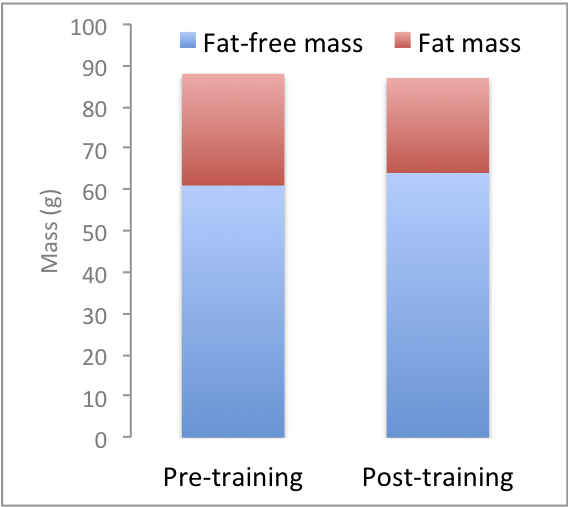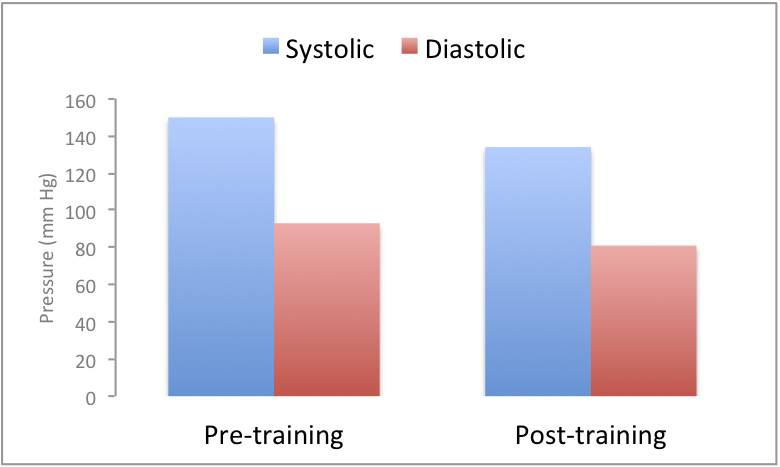A program of regular weight training decreased blood pressure in middle aged hypertensive men. Consider exercise before you rush to medicate yourself.
Ask your doctor what activity improves your health — whether that’s losing weight, fixing your cholesterol profile, or lowering blood pressure — and s/he’ll probably suggest some cardio.
Few health care providers assume that weight training will help, and figure that a good 30 minute jog 5 days a week is much better for your health.
This is particularly true with high blood pressure. In fact, many docs assume that lifting weights is dangerous for blood pressure. But today’s review suggests that weight training can actually help treat hypertension.
What is blood pressure?
Blood pressure is much like the water pressure in the pipes you have at home. It’s a measure of two things:
- the size/diameter of the “pipes”
- how much fluid is being pushed through those pipes.
High water pressure is good. But high blood pressure means vascular damage. It’s linked to stroke, heart disease and early death.
Measuring blood pressure
When you go to your doctor they’ll measure your blood pressure and give you two numbers — for example, “110/80”.
- The first and higher number is the systolic pressure — when your heart is contracting pushing blood out of your heart.
- The second and lower number is the diastolic pressure — when the heart is relaxed and blood is filling the heart.
All these numbers are in millimetres of mercury (mm Hg), the same way we measure other types of pressure like barometric pressure.
Normal and various levels of high blood pressure (hypertension) are shown in table 1.
Even if only one number is high, that can be a problem. For example, if your systolic is 130 (high) and your diastolic is 79 (low), that’s considered prehypertensive.
Table 1: Classification of blood pressure
| Classification | Systolic | Diastolic |
|---|---|---|
| Normal | <120 | <80 |
| Prehypertension | 120-139 | 80-89 |
| Stage 1 hypertension | 140–159 | 90–99 |
| Stage 2 hypertension | ≥160 | ≥100 |
For more on blood pressure, see All About High Blood Pressure .
Research question
Can weight lifting help?
It seems counter-intuitive that lifting weights could improve blood pressure, because blood pressure goes up during the actual weight lifting. This week’s review examines whether a weight training exercise plan can, in fact, help.
Moraes MR, Bacurau RF, Simões HG, Campbell CS, Pudo MA, Wasinski F, Pesquero JB, Würtele M, Araujo RC. Effect of 12 weeks of resistance exercise on post-exercise hypotension in stage 1 hypertensive individuals. J Hum Hypertens. 2011 Jul 7. doi: 10.1038/jhh.2011.67. [Epub ahead of print]
Methods
Participants
This study involved fifteen middle-aged (46 ±8 years old) men with high blood pressure, who exercised less than 2 hours a week. Any man taking medication for blood pressure stopped taking their medication 6 weeks before the start of the study.
Blood pressure
“High blood pressure” was defined as 140-159 mm Hg systolic and 90-99 mm Hg diastolic, or stage 1 hypertension, according to the American Heart Association (take a look at table 1). Anybody with serious medical issues was excluded.
Exercise
The exercise program was done three times a week with at least one day of rest in between (ex. Monday, Wednesday and Friday). It was based on 1 repetition maximums (1RM) from earlier testing and the volunteers did 3 sets of 12 reps at 60% of their 1 RM of the following exercises:
- leg press
- leg curl
- chest press
- lat pulldown
- shoulder press
- biceps curl
- triceps extension
Rest between sets was 1 minute and the exercises were not done in a circuit. All three sets were completed for one exercise before moving on.
Note that the study results only apply to this type of weight training. The program’s main muscular adaptation were increasing muscular endurance with some hypertrophy (3 sets of 12 reps). Until more studies are done with different types of weight training programs, we can’t say if whether other types of programs — such as a low-rep/high-weight strength program — would also be useful.
Results
Body composition
After twelve weeks of working out, on average the men had no significant difference in body mass (88±16 kg to 87±15kg), but more fat-free mass (muscle is included) from 61 ± 9kg to 64 ± 10kg and less fat 27±9 to 23±8 kg (Figure 1). This worked out to a 4% decrease in body fat (30 to 26% body fat) with no difference on the scale.

On average, the men ended up with:
- 3 kg (6.6 lb) more lean mass (likely muscle, water and glycogen)
- 4 kg (8.8 lb) less fat
- 4% less body fat
- 1 kg (2.2 lb) in total body weight
Not bad — with no change in diet these guys lost about a third of a kilogram of fat a week (0.55 lb).
Did I mention the scale is a bad way to measure changes in body composition?
Blood pressure
More lean mass and less fat is nice, but not the point of the study. The question was: Does weight training improve blood pressure in middle aged men with high blood pressure?
The answer to that is yes, weight training improves blood pressure.
Both systolic and diastolic went down after 12 weeks on the program, 16 and 12 mm Hg, respectively (Figure 2). The decrease was enough to shift the group average from being stage 1 hypertension (150/93) to pre-hypertension (134/81).

Conclusion
Twelve weeks of weight training, 3 times a week decreases blood pressure in middle aged men (46 years old) with high blood pressure.
The average systolic reduction was 16 mm Hg, which is about as good or better as any other lifestyle change (see Table 2).
Since a 20 mm Hg increase in systolic blood pressure doubles the risk of ischemic heart disease and stroke, then decreasing systolic blood pressure by almost 20 mm Hg (16 mm Hg) with weight training, you can decrease your risk by half.
Table 2: Lifestyle modifications to prevent and manage hypertension [1]
| Change | Reduction in systolic blood pressure |
|---|---|
| Weight training, 3 x weekly (as studied) | 16 mm Hg |
| Reducing salt to 2.4 g of sodium | 2-8 mm Hg |
| Aerobic exercise of a least 30 minutes a day for most days of the week | 4-9 mm Hg |
| Weight loss | 5-10 mm Hg/10 kg |
Generally, if a patient’s blood pressure is more than 20 mm Hg higher than the normal range (i.e., over 140 mm Hg) they’re given two drugs or a combination drug. So, these men have two options:
- Option A: work out for a little over 2 hours/week with a bunch of positive side effects like having more muscle and less fat, getting stronger, stress relief (which also lowers blood pressure) and looking better naked.
- Option B: take costly medication with potential negative side effects like coughing, dizziness, changes in flavour of foods, and constipation.
It’s a pretty clear choice, I’d say.
Bottom line
Weight training alone can decrease blood pressure in middle aged men with high blood pressure enough to decrease risk of heat disease (ischemic) and stroke by nearly half.
If you’re concerned about your blood pressure, consider a good fitness program — including weight training — before trying medication.
References
Click here to view the information sources referenced in this article.
Eat, move, and live…better.©
The health and fitness world can sometimes be a confusing place. But it doesn't have to be.
Let us help you make sense of it all with this free special report.
In it you'll learn the best eating, exercise, and lifestyle strategies – unique and personal – for you.




Share